“It is important to understand the basic differences between the wild yeast of sourdough and the commercial baker’s yeast in most other breads. First sourdough yeast grow best in acidic doughs, while baker’s yeast does better in neutral or slightly alkaline doughs. Baker’s yeast is a single species, with hundreds of strains and varieties, while sourdoughs are usually leavened by one or more species in the same dough, none of which is baker’s yeast. Baker’s yeast is a highly uniform product that produces an equally uniform texture in bread dough. The wild yeast are anything but uniform, and they vary from country to country. But the most impressive difference between the two yeast types is that a single package of instant dried yeast produces just one batch of bread, while the same amount of wild sourdough culture produces loaf after loaf for the lifetimes of many bakers.”
– Ed Wood, Classic Sourdoughs
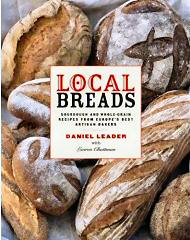 Buenos Aires – Though it was published last year, I just got around to reading through Daniel Leader’s Local Breads. I was particularly interested in this bread baking book because it focuses on sourdough breads from a number of traditional European cultures, and it’s a topic, good sourdough bread, that is, that comes up regularly in expat conversation here. A friend of mine recently went back to the U.S. to visit family and agreed to bring back a couple of different books that I’d wanted, so here was my opportunity. Daniel Leader is well-known for his award winning book Bread Alone that came out in the mid-90s – a solid introduction to the world of bread baking. This new book has gotten rave reviews, with only minimal criticism for at times being a bit technical and dense. I have to admit, I didn’t find it that way, but then, I’m kind of used to reading books of that sort.
Buenos Aires – Though it was published last year, I just got around to reading through Daniel Leader’s Local Breads. I was particularly interested in this bread baking book because it focuses on sourdough breads from a number of traditional European cultures, and it’s a topic, good sourdough bread, that is, that comes up regularly in expat conversation here. A friend of mine recently went back to the U.S. to visit family and agreed to bring back a couple of different books that I’d wanted, so here was my opportunity. Daniel Leader is well-known for his award winning book Bread Alone that came out in the mid-90s – a solid introduction to the world of bread baking. This new book has gotten rave reviews, with only minimal criticism for at times being a bit technical and dense. I have to admit, I didn’t find it that way, but then, I’m kind of used to reading books of that sort.
I am, however, going to point out the emperor’s nudity… just a bit. Overall, I liked the book immensely. It was a completely enjoyable read, and his stories about different regions and his travels are engaging. His recipes are a little repetitive, giving overly detailed step by step instructions, over and over again – but then, most people probably are not sitting down to read the book cover to cover – they’re picking out one or two recipes and trying those out – so they don’t really want to be flipping back and forth to previously referenced techniques. I can’t really fault him there. I did find his writing to be a bit… hypocritically humble – hmm… maybe that’s not quite the phrase. He constantly bows and scrapes to the various bakers he talks about, as if each, in turn, is some sort of godlike figure in the world of baking – producing the ultimate loaf of bread of their style. He then turns around, one by one, and discusses how he took their product and “perfected it”. Beyond the presumption that he can take on the recipes of the gods (maybe he just writes about them as if they were on pedestals…), his regular assertion of his ability to turn these humble (yet deity-produced) loaves into his version of perfection, is a bit off-putting. Sort of like listening to that guy at a cocktail party who stands there while you’re talking, tapping his foot and waiting for his turn to tell you you have an interesting idea, but he has a better one.
My biggest problem with the book is his math. Initially, it didn’t catch my eye, until I hit the phrase in his section on German breads – “He told me that the average German eats a kilo of bread a week – about 10 ounces of bread a day.” and then goes on to talk about how this seems to be alot in comparison to Americans. Mmmm… no, a kilo a week would be 5 ounces a day, pretty much the same as the amount he talks about for Americans. Either he meant 2 kilos a week, or he simply got his math wrong. I would have just discounted it as a simple mistake, only when I started out to try his recipes, I found similar problems with the numbers.
I decided to start off with his section on liquid levain – a watery sort of sourdough starter that is all the rage amongst a certain group of French bakers these days. The levain itself turned out to be quite easy to make, a simple mix of 2/3 cup of water and 6 tablespoons of flour… hmmm… that is quite a bit of water, no? Left to sit with various stirrings and daily additions of 1/3 cup each of flour and water. Over the course of four days it turned into a bubbling, fermenting container of delightful smelling levain the consistency of light cream.
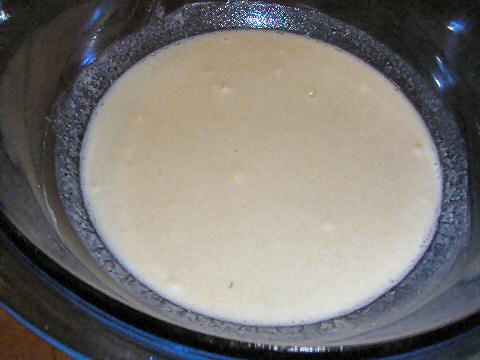
In the beginning – just mixed
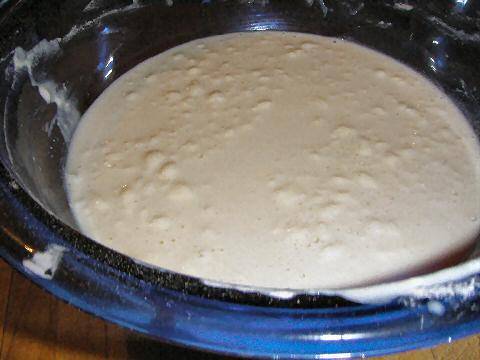
After 48 hours, with two additions of water and flour
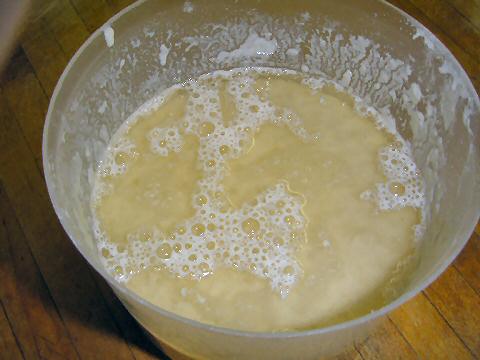
After four days and four additions, bubbling and ready to use.
That was all well and good and I was excited and ready to go. My first inkling that something was amiss was as I mixed the ingredients for his Baguette à l’ancienne, an old world style baguette. He talks regularly in the book about doughs that are hydrated more than what we’re used to working with. But this was like thin pancake batter. He didn’t give a detailed description of consistency, merely that it would be far softer than what one would normally think of, and he does say it will be a challenge. At the same time, though he opts for machine kneading, he asserts that it’s possible to hand knead this dough, with care. that wouldn’t have been possible with this – it would have simply poured onto the counter and dripped off onto the floor. I looked back at the numbers in his recipe, and sure enough, his proportion of water to flour comes out pretty close to 1:1 – I mean, even a “wet dough” is generally only about 2/3 the amount of liquid to flour, and most people work with bread doughs that are more like 1:2. Top that with past experience here that the flours here need extra water in comparison to what I’m used to in the U.S., and something was clearly wrong. Still, I gave the mixer a try – he asserted that after 8-9 minutes of high speed mixing the dough would take on the consistency of a marshmallow. Maybe if it’s been melted over high heat…

So, I added in flour – high gluten bread flour in fact to help it develop some structure, almost 50% more than his recipe called for before I got something that was remotely marshmallow-like. At that point I wasn’t going to even try to shape this mess into baguettes and simply poured it into greased mini-loaf pans, let it proof for a couple of hours (it did rise… though slowly), and then baked out these little loaves. The taste was great – the lightly tangy sourdough flavor – and with the extra flour the consistency was okay – though not really baguette-like.
And, I moved on… more cautiously now. I’d already decided I wanted to also try his recipe for Pain de campagne, more commonly referred to as boules. I decided to approach this carefully, as looking at the recipe I could already see that the liquid to flour was at 85% and I wasn’t looking forward to a liquid mess. So I added only about half the water upfront, figuring on adding in more as needed. In the end, I needed very little more, a matter of a couple of tablespoons, and bringing the liquid ratio down to about 65%. From that, I got a nice, soft, pillowy dough, that fit his description perfectly. I continued with the rest of the process, and, voila! Boules.
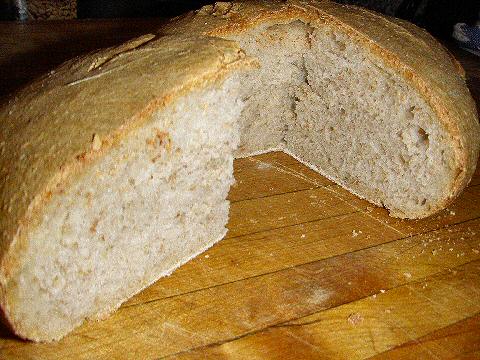
Now, to this point, I’ve only tried those two recipes, in the section of liquid levain. I have yet to delve into the making of others, though I’m going to continue trying out various ones over the coming weeks and months. My sourdough starter is bubbling away, and I’m feeding it and chatting with it on a daily basis. I’ve read a few blog entries by various other folks who’ve tried different recipes (the most common choice seems to be his basic yeast baguette recipe, different from the one I tried above), that seem to have had good results.
So the question I’m left with is… is his math just off or is there something so very different about the flour here? If anything, I’d have expected based on past experience that if it was the latter that I’d have needed more water, not less, so it leads me to think his math is off, or the book wasn’t carefully proofread. More tests and trials to come….
Other last notes on the book – which may add credence to the proofreading hypothesis – there are numerous typos in the book when it comes to foreign words, a simple example, he refers to an Italian tomato bread as al pomodori – mixing the singular article with the plural noun – I realize that’s not something that everyone will notice, but it’s something he should have (it should be either al pomodoro or ai pomodori). And back to that sort of conceit mentioned above – he subtitles the book Sourdough and Whole-Grain Recipe from Europe’s Best Artisan Bakers, yet, his travels (at least as detailed within the book), and recipes, only cover parts of France, Italy, Germany, and a very brief look at Czechoslavakia in search of one particular bread. Europe’s a whole lot more than that, and there are wonderful artesanal breads from many other countries and cultures – perhaps, who knows, perhaps better than the ones he terms Best.
I love your articles!, all of them!
greetings from Orlando
Nancy
With a bit more experimentation, I’m leaning towards the “flour” as the culprit, though I’m still at a loss to explain why the recipes in this book require less water on my part for the flour here than more, which is what has happened with virtually every other bread recipe I’ve tried here. I re-tried making the baguettes, but this time adding the liquid a little at a time until I got the consistency that he described in the book. And, indeed, after kneading in the mixer for his recommended 8-9 minutes, the dough was exactly the consistency of the inside of a marshmallow. Which also means it’s really sticky. And, in fact, though they baked up beautifully as you can see, they literally absorbed the parchment paper into their base, I couldn’t remove them, and had to simply slice off the bottoms of the baguettes… a shame! Still, the flavor was great, I’ll be doing these again, probably with a little more modification, and using a silpat for the baking.
I also tried one of the recipes from the whole grain bread section, not using the liquid sourdough starter. A corn-rye, absolutely delicious (though very dense and chewy, something he stated upfront), and this is where I began to feel that the flour is more the issue – since this dough is only part wheat flour, and a good percentage corn and rye, and the quantity of liquid he gave was much closer to the amount that worked to get the consistency he talked about. It was still off by about 20-25%, but that’s down from 30-35% on the other recipes.
[…] Buenos Aires – More recent bread experiments… […]
Thanks so much for posting these detailed pics. I’ve been experimenting with homemade sourdough starter here in Buenos Aires, and was looking online to try to find some clue as to how I could tell when it was sufficiently fermented. My starter is a little bubbly, but doesn’t seem to be really becoming frothy like many of the photos I’ve seen online….and I was wondering whether that was environmental.
I guess I’ll just keep experimenting maybe try a loaf and see what happens.